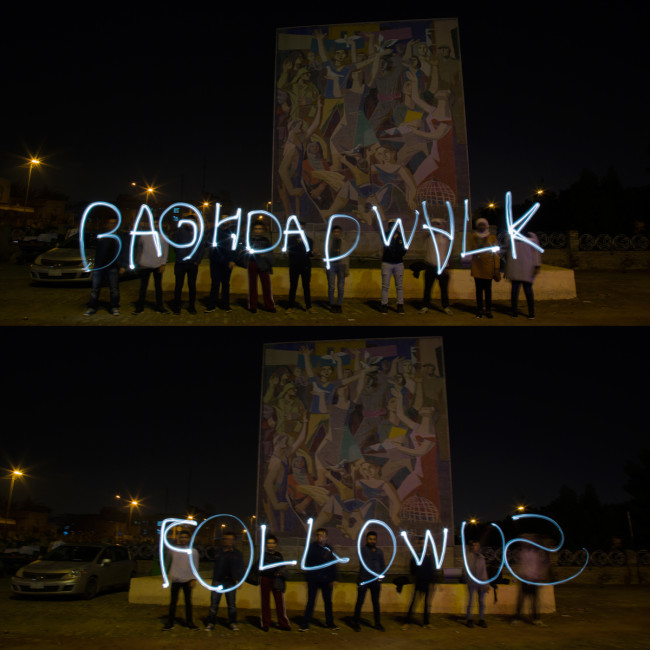16 - 17 November 2018 / Collaboration, Exhibition ⟶
Baghdad Walk I
BAGHDAD WALK
Group exhibition in public space
Baghdad Walk is a group exhibition by emerging Iraqi artists presented in the public space and in different locations in Karada, Baghdad. The walk starts at Iraqi Independent Film Centre, leads along Al Rasheed Street to Midan Square, connects Tayeran Square, Tahrir Square and Kahramana Square, spreads along the Abu Nawas riverside and meanders through Karada neighborhood, featuring time-based works and interventions.
Baghdad Walk is an exhibition and a narrative tour of the city. The participating artists connect their works with the specific locations, introducing background information on site. Manifold stories about the city of Baghdad are told and retold anew through the artists’ perspectives and the encounters they create.
Participants:
Ahmed Al Saad, Tabarek Al Atrakchi, Akram Assam, Ameen Mokdad, Ammar Hussein, Atef Al Jaffal, Hussam Mohammed, Hussain Muttar, Loay Al Hadhary, Muhaned Taha, Zaid Saad.
—
Please find the project’s bilingual (Englisch-Arabic) website here.
—
Baghdad Walk is the result of a workshop series Arts Seminar in Baghdad, conceived and organised by the Goethe-Institut Irak, in collaboration with the Institut für Raumexperimente (Institut for Spatial Experiments), Berlin and hosted by TARKIB Baghdad Contemporary Arts Institute in BAIT TARKIB. Hosted by TARKIB Baghdad Contemporary Arts Institute. Choreographed by Hella Mewis and Christina Werner
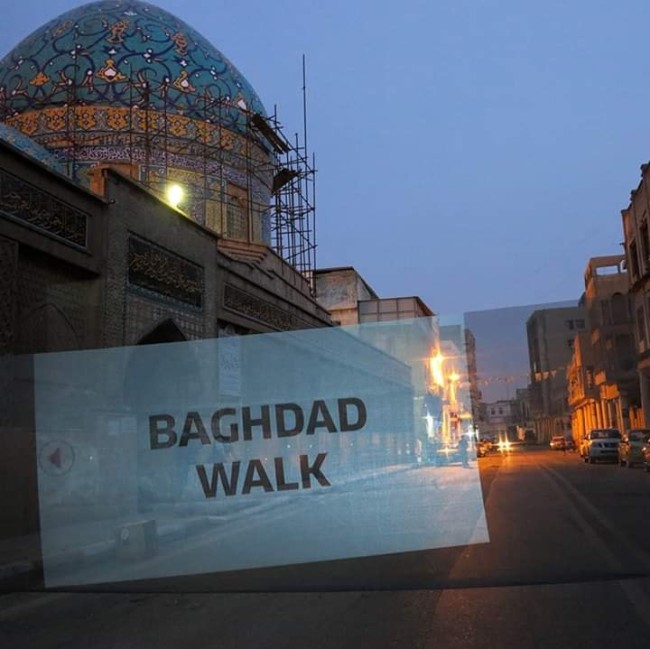
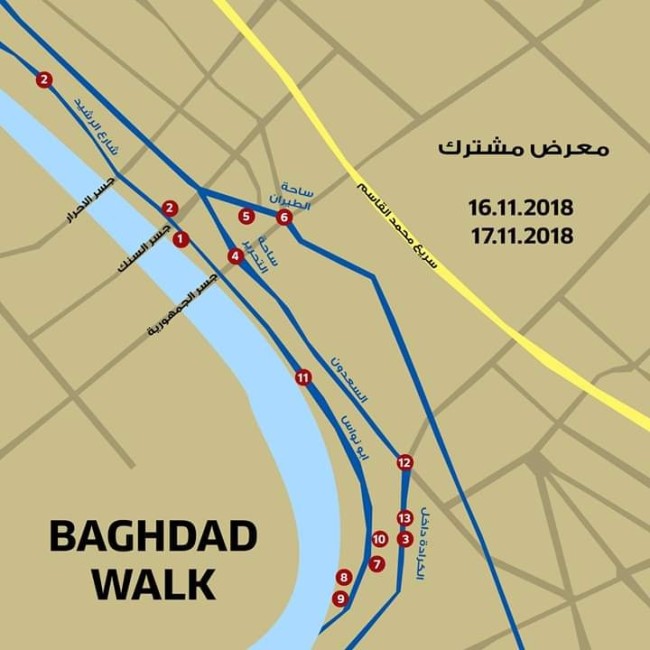
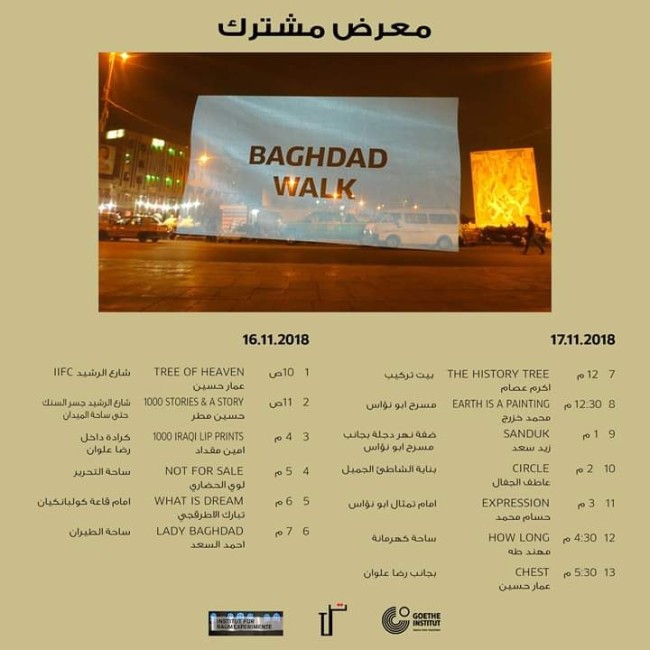
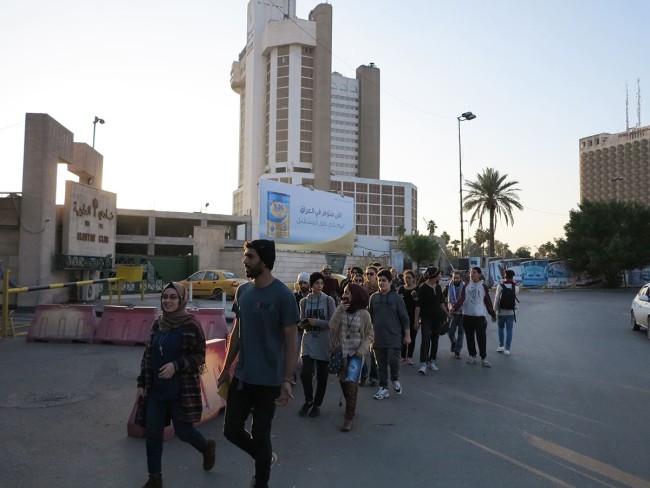
Baghdad Walk – Follow us
The two-day walk started at the Iraqi Independent Film Centre, led along Al Rasheed Street to Midan Square, connected Karada Dajel with Tayeran Square and Tahrir Square; it led from Tarkib Baghdad Contemporary Arts Institute to the Abu Nawas Theater, spread along the Abu Nawas riverside and meandered through Karada neighborhood from Kahramana Square to Ridah Alwan Coffeeshop.
Please find the documentation of each of the artist’s interventions on the following pages.
Photo by Anees Amer
Photo by Anees Amer
Photo by Christina Werner
Photo by Anees Amer
Photo by Yasir Razaq/Mahdi Al-Shididy
Photo by Anees Amer
Photo by Anees Amer
Photo by Yasir Razaq/Mahdi Al-Shididy
Photo by Anees Amer
Photo by Hella Mewis
Photo by Christina Werner
Photo by Hella Mewis
Photo by Yasir Razaq/Mahdi Al-Shididy
Photo by Christina Werner
Photo by Hella Mewis
Photo by Hella Mewis
Photo by Christina Werner
Photo by Hella Mewis
The two-day walk started at the Iraqi Independent Film Centre, led along Al Rasheed Street to Midan Square, connected Karada Dajel with Tayeran Square and Tahrir Square; it led from Tarkib Baghdad Contemporary Arts Institute to the Abu Nawas Theater, spread along the Abu Nawas riverside and meandered through Karada neighborhood from Kahramana Square to Ridah Alwan Coffeeshop.
Please find the documentation of each of the artist’s interventions on the following pages.
Photo by Anees Amer
Photo by Anees Amer
Photo by Christina Werner
Photo by Anees Amer
Photo by Yasir Razaq/Mahdi Al-Shididy
Photo by Anees Amer
Photo by Anees Amer
Photo by Yasir Razaq/Mahdi Al-Shididy
Photo by Anees Amer
Photo by Hella Mewis
Photo by Christina Werner
Photo by Hella Mewis
Photo by Yasir Razaq/Mahdi Al-Shididy
Photo by Christina Werner
Photo by Hella Mewis
Photo by Hella Mewis
Photo by Christina Werner
Photo by Hella Mewis
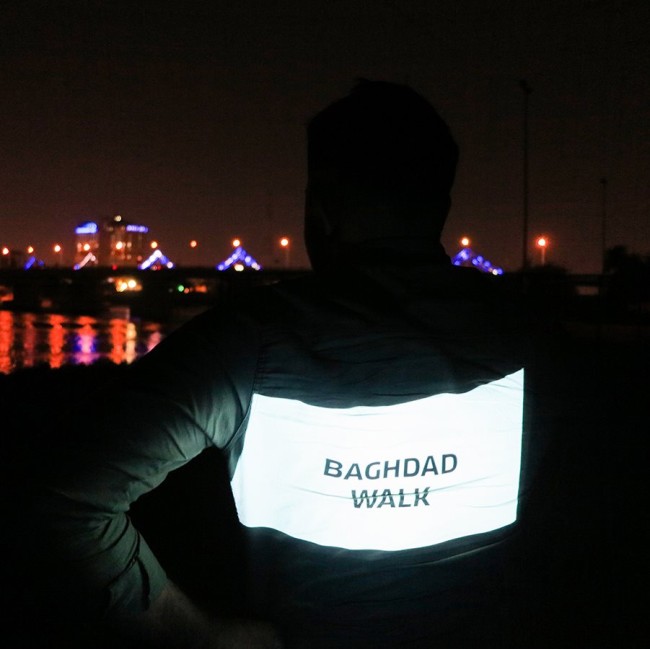
1. Ammar Hussein
Ammar Hussein: Tree of HeavenAt the Iraqi Independent Film Center (IIFC)
Photo by Yasir Razaq/Mahdi Al-Shididy
Photo by Yasir Razaq/Mahdi Al-Shididy
Photo by Yasir Razaq/Mahdi Al-Shididy
Photo by Yasir Razaq/Mahdi Al-Shididy
Photo by Yasir Razaq/Mahdi Al-Shididy
Photo by Anees Amer
TREE OF HEAVEN by Ammar Hussein presented five montage works combining different types of processed wood on canvas. The works were arranged on the ground, set into the soil of a former yard. Hussain highlights the significance of the medium of wood and its importance to humanity, both in our built environment and in narrative traditions. The installation was presented in the yard of the Iraqi Independent Film Center (IIFC), a shanasheel building constructed in the early 1920s on Al Rasheed Street. The IIFC plays a pioneering role in the independent arts and creative industries in Baghdad. The building is currently under renovation, and its traditional shanasheel features, for instance, the finely crafted bay windows, were once completed with intricate wooden latticework and ornate stained glass, which allow inhabitants to see outside without being seen.
Ammar Hussein: Tree of HeavenAt the Iraqi Independent Film Center (IIFC)
Photo by Yasir Razaq/Mahdi Al-Shididy
Photo by Yasir Razaq/Mahdi Al-Shididy
Photo by Yasir Razaq/Mahdi Al-Shididy
Photo by Yasir Razaq/Mahdi Al-Shididy
Photo by Yasir Razaq/Mahdi Al-Shididy
Photo by Anees Amer
TREE OF HEAVEN by Ammar Hussein presented five montage works combining different types of processed wood on canvas. The works were arranged on the ground, set into the soil of a former yard. Hussain highlights the significance of the medium of wood and its importance to humanity, both in our built environment and in narrative traditions. The installation was presented in the yard of the Iraqi Independent Film Center (IIFC), a shanasheel building constructed in the early 1920s on Al Rasheed Street. The IIFC plays a pioneering role in the independent arts and creative industries in Baghdad. The building is currently under renovation, and its traditional shanasheel features, for instance, the finely crafted bay windows, were once completed with intricate wooden latticework and ornate stained glass, which allow inhabitants to see outside without being seen.
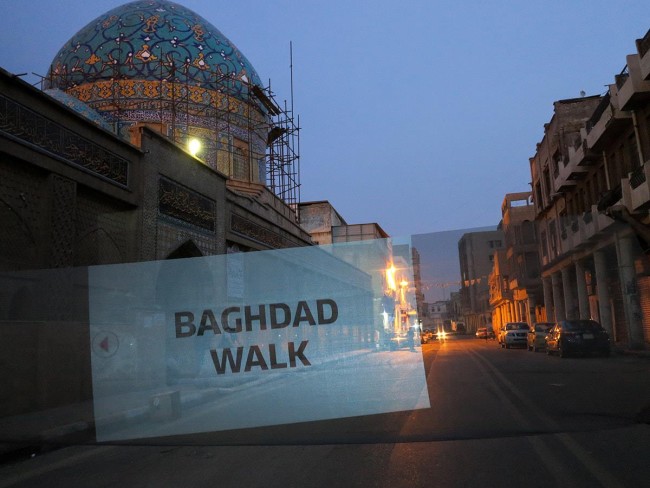
2. Hussain Muttar
Hussain Muttar: 1000 Stories & A StoryAt Al Rasheed Street
Photo by Christina Werner
Photo by Christina Werner
Photo by Yasir Razaq/Mahdi Al-Shididy
Photo by Christina Werner
Photo by Hella Mewis
Photo by Christina Werner
Photos by Christina Werner
Hussain Muttar’s 1000 STORIES AND A STORY is based on his on-going research. He collects historical photographs of Baghdad city views from archives as well as from private households and reconstructs the images in the present day, photographing the same location from the same angles and perspectives. For BAGHDAD WALK, he chose to present comparisons of architectural landscapes, landmarks, and sights in Baghdad. The work juxtaposes past and present, installing large posters of the historical and current photographs of facades and buildings of Al Rasheed Street along that very street, covering a distance of 2.7 kilometres from Zinek Bridge to Midan Square. Muttar’s ambition is to raise awareness of Baghdas architectural heritage and to encourage residents to see their neighbourhood’s rich history. He involves the local community by collecting the photos and stories about the buildings and their use and function, and he depends on the cooperation of residents to access rooftops and sites in order to reconstruct the original perspectives. For BAGHDAD WALK, Muttar chose to present ten sites on Al Rasheed Street, not just to highlight the richness of architectural tradition, but also to emphasise how architecturally and historically valuable treasures dwindle away through human misuse and neglect.
Hussain Muttar: 1000 Stories & A StoryAt Al Rasheed Street
Photo by Christina Werner
Photo by Christina Werner
Photo by Yasir Razaq/Mahdi Al-Shididy
Photo by Christina Werner
Photo by Hella Mewis
Photo by Christina Werner
Photos by Christina Werner
Hussain Muttar’s 1000 STORIES AND A STORY is based on his on-going research. He collects historical photographs of Baghdad city views from archives as well as from private households and reconstructs the images in the present day, photographing the same location from the same angles and perspectives. For BAGHDAD WALK, he chose to present comparisons of architectural landscapes, landmarks, and sights in Baghdad. The work juxtaposes past and present, installing large posters of the historical and current photographs of facades and buildings of Al Rasheed Street along that very street, covering a distance of 2.7 kilometres from Zinek Bridge to Midan Square. Muttar’s ambition is to raise awareness of Baghdas architectural heritage and to encourage residents to see their neighbourhood’s rich history. He involves the local community by collecting the photos and stories about the buildings and their use and function, and he depends on the cooperation of residents to access rooftops and sites in order to reconstruct the original perspectives. For BAGHDAD WALK, Muttar chose to present ten sites on Al Rasheed Street, not just to highlight the richness of architectural tradition, but also to emphasise how architecturally and historically valuable treasures dwindle away through human misuse and neglect.
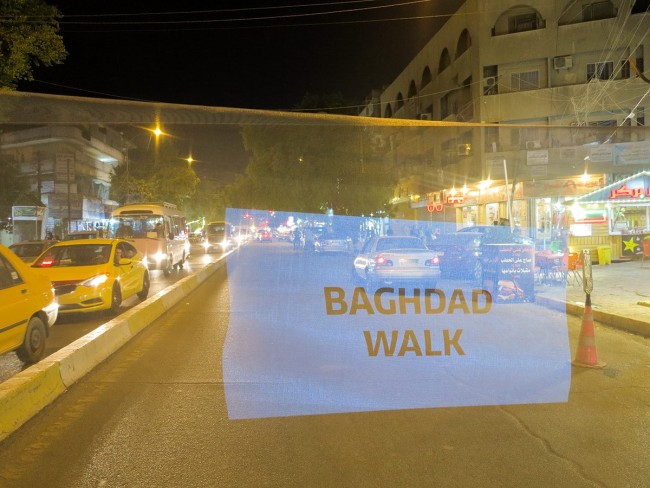
3. Ameen Mokdad
Ameen Mokdad: 1000 Iraqui Lip PrintsAt Karada Ridha Alwan
Photos by Christina Werner
Videos by Christina Werner
Ameen Mokdad collected 1000 empty water bottles that littered the streets of Baghdad with his own hands and formed a large sphere from the waste material. This huge plastic ball was returned to the street, placed in the middle of Karada Dajel in front of Ridha Alwan Café and blocking traffic. 1000 IRAQI LIP PRINTS are 1000 pieces of evidence of polluting crime happening every second in Baghdad, the lip prints tracing back to the very DNA of individual involvement. With his intervention, Mokdad wanted to create awareness of the enormous amount of waste in Baghdad’s streets and how this is influenced by our understanding of which spaces we care for and how habits and responsibility for communal spaces are intertwined. The intervention took place on Karada Dajel, a thriving shopping street at the heart of the city of Karada, in front of the art cafe Ridha Alwan, where socially diverse clientele meet under one roof. The spot seemed ideal for eliciting diverse reactions from a mixed crowd in a quite everyday situation. To Mokdad, it was important that the audience comprised inhabitants of Baghdad, who can achieve change if they want.
Ameen Mokdad: 1000 Iraqui Lip PrintsAt Karada Ridha Alwan
Photos by Christina Werner
Videos by Christina Werner
Ameen Mokdad collected 1000 empty water bottles that littered the streets of Baghdad with his own hands and formed a large sphere from the waste material. This huge plastic ball was returned to the street, placed in the middle of Karada Dajel in front of Ridha Alwan Café and blocking traffic. 1000 IRAQI LIP PRINTS are 1000 pieces of evidence of polluting crime happening every second in Baghdad, the lip prints tracing back to the very DNA of individual involvement. With his intervention, Mokdad wanted to create awareness of the enormous amount of waste in Baghdad’s streets and how this is influenced by our understanding of which spaces we care for and how habits and responsibility for communal spaces are intertwined. The intervention took place on Karada Dajel, a thriving shopping street at the heart of the city of Karada, in front of the art cafe Ridha Alwan, where socially diverse clientele meet under one roof. The spot seemed ideal for eliciting diverse reactions from a mixed crowd in a quite everyday situation. To Mokdad, it was important that the audience comprised inhabitants of Baghdad, who can achieve change if they want.
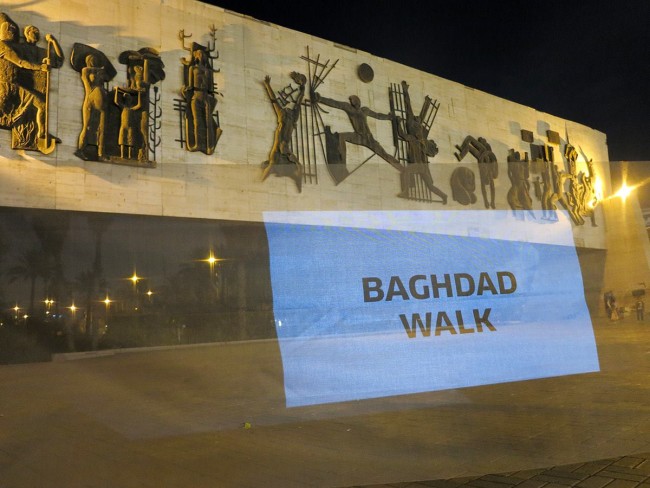
4. Loay Al Hadhary
Loay Al Hadhary: Not For SaleAt Tahrir Square
Photo by Yasir Razaq/Mahdi Al-Shididy
Photo by Yasir Razaq/Mahdi Al-Shididy
Photo by Yasir Razaq/Mahdi Al-Shididy
Photo by Anees Amer
Photo by Anees Amer
Photo by Hella Mewis
The sculpture NOT FOR SALE by Loay Al Hadhary shows a Yazidi woman wrapped in plastic foil, which represents the traditional Abaya robe. Underneath the semi-transparent veil, her naked skin is covered with marks, inscriptions of newspaper clippings and symbols that refer to slavery and misuse. Her hands are raised, tearing a chain apart. The statue stands for the fate of thousands of Yazidi women, kidnapped, enslaved, sold, and raped by members of the Islamic State (IS) during the years of genocide of the Yazidi community in Iraq. Al Hadhari positioned the sculpture underneath the Freedom Monument, known as Nasb al-Hurriyah, by sculptor Jawad Saleem and architect Rifat Chadirji, at Tahrir Square (Liberation Square), where people have historically held demonstrations. The monument was unveiled in 1961; it expresses the struggle of the Iraqi people before the 14 July Revolution in 1958 and commemorates the establishment of the Republic of Iraq. The monument symbolises the people’s strife against tyranny, a struggle that hasn’t been put to an end, fought again in the present day. IS has been pursuing a genocidal campaign against the Yazidi of Sinjar in northern Iraq, but to date, no perpetrator has been held accountable for the genocide.
Loay Al Hadhary: Not For SaleAt Tahrir Square
Photo by Yasir Razaq/Mahdi Al-Shididy
Photo by Yasir Razaq/Mahdi Al-Shididy
Photo by Yasir Razaq/Mahdi Al-Shididy
Photo by Anees Amer
Photo by Anees Amer
Photo by Hella Mewis
The sculpture NOT FOR SALE by Loay Al Hadhary shows a Yazidi woman wrapped in plastic foil, which represents the traditional Abaya robe. Underneath the semi-transparent veil, her naked skin is covered with marks, inscriptions of newspaper clippings and symbols that refer to slavery and misuse. Her hands are raised, tearing a chain apart. The statue stands for the fate of thousands of Yazidi women, kidnapped, enslaved, sold, and raped by members of the Islamic State (IS) during the years of genocide of the Yazidi community in Iraq. Al Hadhari positioned the sculpture underneath the Freedom Monument, known as Nasb al-Hurriyah, by sculptor Jawad Saleem and architect Rifat Chadirji, at Tahrir Square (Liberation Square), where people have historically held demonstrations. The monument was unveiled in 1961; it expresses the struggle of the Iraqi people before the 14 July Revolution in 1958 and commemorates the establishment of the Republic of Iraq. The monument symbolises the people’s strife against tyranny, a struggle that hasn’t been put to an end, fought again in the present day. IS has been pursuing a genocidal campaign against the Yazidi of Sinjar in northern Iraq, but to date, no perpetrator has been held accountable for the genocide.
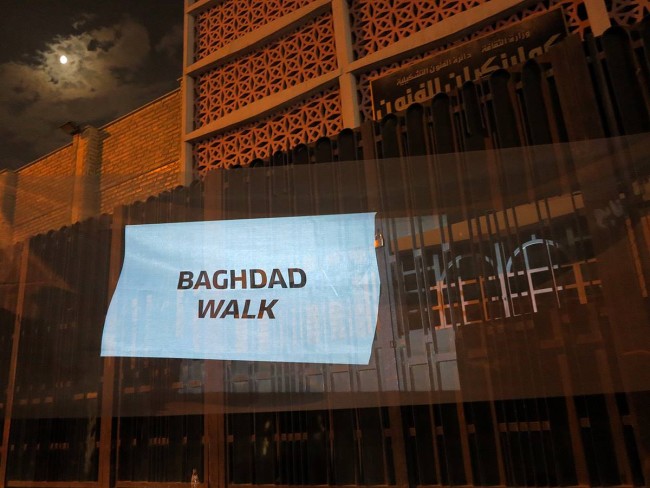
5. Tabarek Al Atrakchi
Tabarek Al Atrakchi: What Is A DreamIn front of the Calouste Gulbenkian Museum/Museum of Modern Art
Photo by Christina Werner
Photo by Anees Amer
Photo by Christina Werner
Photo by Christina Werner
The installation WHAT IS A DREAM by Tabarek Al Atrakchi showed a series of crayon drawings made by street kids, in an installation setting that included an arabana (a kind of wheelbarrow for transporting goods) loaded with water bottles, chewing gum, and cleaning materials – all items that are typically sold by children on the street. Al Atrakchi sought out the children in the city streets and asked them to draw their dreams and to tell her what those dreams were about. WHAT IS A DREAM depicts the hopes and future visions of the children. The dreams range from having a boat to work on the river and becoming a photographer or a doctor to travelling to an island in the turquoise sea. Al Atrakchi criticises child labour and the living conditions of many street kids in Iraq by looking into their wishes for a future that contrasts their everyday situation. She presented her artwork in front of the Museum of Modern Art in Baghdad, the first exhibition space for modern art in Iraq, built in 1962 and also known as ‘The Gulbenkian Hall’. The place embodies a collision of worlds that is typical for Baghdad: the governmental, state-run art museum is located in the midst of a bazaar that gathers small businesses, day labourers, and the poorest of the city, from thieves to street kids. The children’s drawings on the street stand in an imagined dialogue with the art inside the galleries, while they show how far removed one reality is from the other.
Tabarek Al Atrakchi: What Is A DreamIn front of the Calouste Gulbenkian Museum/Museum of Modern Art
Photo by Christina Werner
Photo by Anees Amer
Photo by Christina Werner
Photo by Christina Werner
The installation WHAT IS A DREAM by Tabarek Al Atrakchi showed a series of crayon drawings made by street kids, in an installation setting that included an arabana (a kind of wheelbarrow for transporting goods) loaded with water bottles, chewing gum, and cleaning materials – all items that are typically sold by children on the street. Al Atrakchi sought out the children in the city streets and asked them to draw their dreams and to tell her what those dreams were about. WHAT IS A DREAM depicts the hopes and future visions of the children. The dreams range from having a boat to work on the river and becoming a photographer or a doctor to travelling to an island in the turquoise sea. Al Atrakchi criticises child labour and the living conditions of many street kids in Iraq by looking into their wishes for a future that contrasts their everyday situation. She presented her artwork in front of the Museum of Modern Art in Baghdad, the first exhibition space for modern art in Iraq, built in 1962 and also known as ‘The Gulbenkian Hall’. The place embodies a collision of worlds that is typical for Baghdad: the governmental, state-run art museum is located in the midst of a bazaar that gathers small businesses, day labourers, and the poorest of the city, from thieves to street kids. The children’s drawings on the street stand in an imagined dialogue with the art inside the galleries, while they show how far removed one reality is from the other.
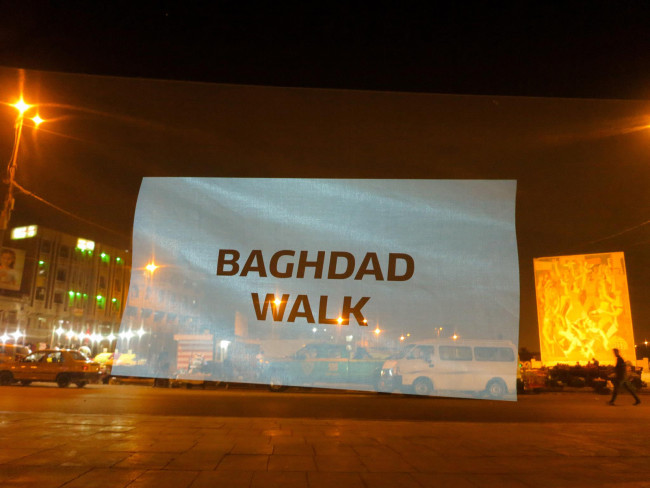
6. Ahmed Al Saad
Ahmed Al Saad: Lady Baghdad. In collaboration with Tabarek Al AtrakchiAt Tayeran Square
Photos by Christina Werner
Ahmed Al Saad: Lady Baghdad. 2018
The video installation LADY BAGHDAD used documentation of an intervention by Ahmed Al Saad in collaboration with Tabarek Al Atrackchi. The pop-art-style video shows a young woman playing the violin in front of the The Freedom Monument, a large-scale mosaic by Faek Hassan at al-Tayaran Square. A guitar player joins the violinist for a spontaneous street concert, while a female artist makes live drawings of the situation. Al Saad’s video captures both the artistic interaction and the urban surroundings and goings-on. For BAGHDAD WALK, Al Saad projected the video at night in front of the monument where the intervention had taken place. Installed on a traffic island, the video screen faced one way, while on the opposite side of the screen, Al Atrackchi installed a canvas with her drawings, capturing the moments of the intervention in another medium. With LADY BAGHDAD, Al Saad wants to encourage women be more present in public life in Baghdad and to increase their visibility in the cityscape. Al-Tayaran Square is an important public space and transportation hub in Baghdad, at the foot of Baghdad’s Alumma Park, opposite Tahrir Square. The mosaic monument Celebration of Victory, by Faek Hassan, erected in the 1960s, is widely visible and depicts a celebrating crowd with women and freed doves. It was the first mosaic in Baghdad representing the people’s desire to live together in peace and harmony. Al Saad references an artwork and a time with a potent emphasis on equality and quality of life.
Ahmed Al Saad: Lady Baghdad. In collaboration with Tabarek Al AtrakchiAt Tayeran Square
Photos by Christina Werner
Ahmed Al Saad: Lady Baghdad. 2018
The video installation LADY BAGHDAD used documentation of an intervention by Ahmed Al Saad in collaboration with Tabarek Al Atrackchi. The pop-art-style video shows a young woman playing the violin in front of the The Freedom Monument, a large-scale mosaic by Faek Hassan at al-Tayaran Square. A guitar player joins the violinist for a spontaneous street concert, while a female artist makes live drawings of the situation. Al Saad’s video captures both the artistic interaction and the urban surroundings and goings-on. For BAGHDAD WALK, Al Saad projected the video at night in front of the monument where the intervention had taken place. Installed on a traffic island, the video screen faced one way, while on the opposite side of the screen, Al Atrackchi installed a canvas with her drawings, capturing the moments of the intervention in another medium. With LADY BAGHDAD, Al Saad wants to encourage women be more present in public life in Baghdad and to increase their visibility in the cityscape. Al-Tayaran Square is an important public space and transportation hub in Baghdad, at the foot of Baghdad’s Alumma Park, opposite Tahrir Square. The mosaic monument Celebration of Victory, by Faek Hassan, erected in the 1960s, is widely visible and depicts a celebrating crowd with women and freed doves. It was the first mosaic in Baghdad representing the people’s desire to live together in peace and harmony. Al Saad references an artwork and a time with a potent emphasis on equality and quality of life.
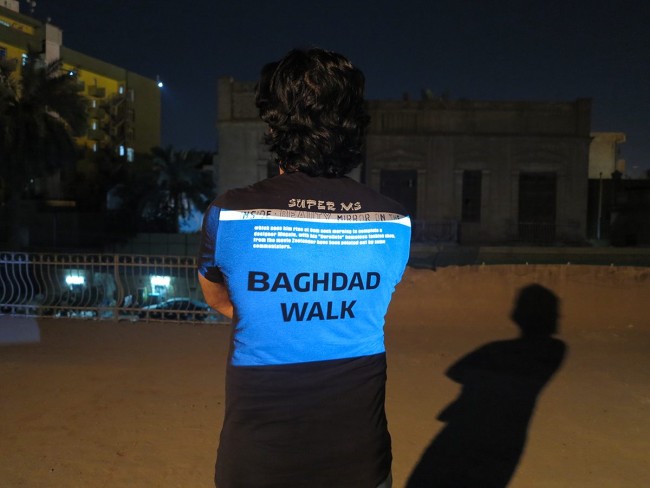
7. Akram Assam
Akram Assam: The History TreeAt Bait Tarkib
Photos by Christina Werner
Photo by Yasir Razaq/Mahdi Al-Shididy
THE HISTORY TREE by Akram Assam was an installation of a tree trunk, and the annual rings on its surface were painted in a variety of colours. Larger coloured ellipses were also drawn into the packed earth surrounding the trunk, resembling planetary orbits. Each coloured ring reflected a historical period of the Republic of Iraq, and the rings on the ground expanded beyond the lifetime of the tree. Each visitor was invited to take a notepad and write down an event that was an important marker in time for them, imagining the relation of the life span of the tree, their individual lifetime, and the historical moment. Placed on the rooftop of the creative arts centre BAIT TARKIB, the tree – when imagined in full growth – seems to blend in with the row of palm trees in the neighbouring yards. It rooted the location of BAIT TARKIB in the neighbourhood and the city’s history. BAIT TARKIB is in a typical Baghdad building, originally a family home that was built in the 1920s, when the Republic of Iraq was founded.
Akram Assam: The History TreeAt Bait Tarkib
Photos by Christina Werner
Photo by Yasir Razaq/Mahdi Al-Shididy
THE HISTORY TREE by Akram Assam was an installation of a tree trunk, and the annual rings on its surface were painted in a variety of colours. Larger coloured ellipses were also drawn into the packed earth surrounding the trunk, resembling planetary orbits. Each coloured ring reflected a historical period of the Republic of Iraq, and the rings on the ground expanded beyond the lifetime of the tree. Each visitor was invited to take a notepad and write down an event that was an important marker in time for them, imagining the relation of the life span of the tree, their individual lifetime, and the historical moment. Placed on the rooftop of the creative arts centre BAIT TARKIB, the tree – when imagined in full growth – seems to blend in with the row of palm trees in the neighbouring yards. It rooted the location of BAIT TARKIB in the neighbourhood and the city’s history. BAIT TARKIB is in a typical Baghdad building, originally a family home that was built in the 1920s, when the Republic of Iraq was founded.
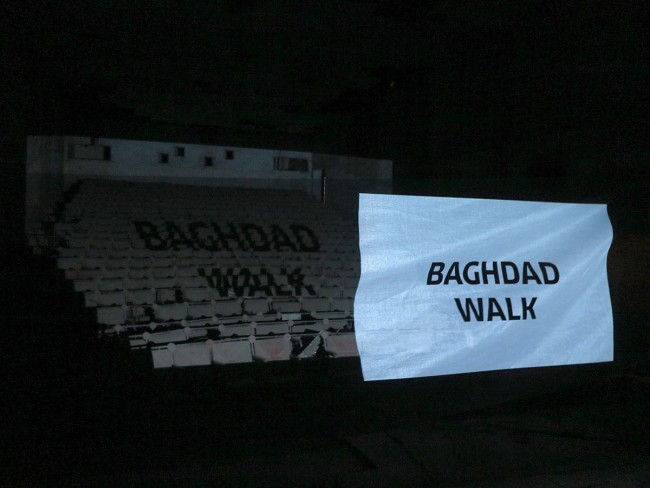
8. Ameen Mokdad
Ameen Mokdad: Sonic InterventionAt Abu Nawas Theater
Photo by Christina Werner
Photo by Hella Mewis
Photo by Yasir Razaq/Mahdi Al-Shididy
Video by Christina Werner
Composer and musician Ameen Mokdad conducted a body-percussion event, using the human body as an instrument to create sounds and vibrations. All participants in the BAGHDAD WALK were invited to join on stage and take part in the performance. The group exercise took place on the stage of the derelict, empty, and unused Abu Nawas Theatre, playing off the architectural features and astounding acoustics of the space. Mokdad is interested in activating social interaction through music; the participants were encouraged to listen to each other, letting the rhythm of their movements fall in sync, creating a small concert with nothing more than an exercise of collaboration. While everyone involved was both on stage and ‘in’ the audience at the same time, they experienced a sense of what the building once was, and what it could be used for again. The Abu Nawas Theatre was once one of the main attractions on the boulevard Abu Nawas, which follows the riverside of the Tigris and mostly used to host film screenings. Because the unresolved property situation today keeps private investors away, the theatre building is currently in the hands of the city administration and mainly used as a waste-disposal site.
Ameen Mokdad: Sonic InterventionAt Abu Nawas Theater
Photo by Christina Werner
Photo by Hella Mewis
Photo by Yasir Razaq/Mahdi Al-Shididy
Video by Christina Werner
Composer and musician Ameen Mokdad conducted a body-percussion event, using the human body as an instrument to create sounds and vibrations. All participants in the BAGHDAD WALK were invited to join on stage and take part in the performance. The group exercise took place on the stage of the derelict, empty, and unused Abu Nawas Theatre, playing off the architectural features and astounding acoustics of the space. Mokdad is interested in activating social interaction through music; the participants were encouraged to listen to each other, letting the rhythm of their movements fall in sync, creating a small concert with nothing more than an exercise of collaboration. While everyone involved was both on stage and ‘in’ the audience at the same time, they experienced a sense of what the building once was, and what it could be used for again. The Abu Nawas Theatre was once one of the main attractions on the boulevard Abu Nawas, which follows the riverside of the Tigris and mostly used to host film screenings. Because the unresolved property situation today keeps private investors away, the theatre building is currently in the hands of the city administration and mainly used as a waste-disposal site.
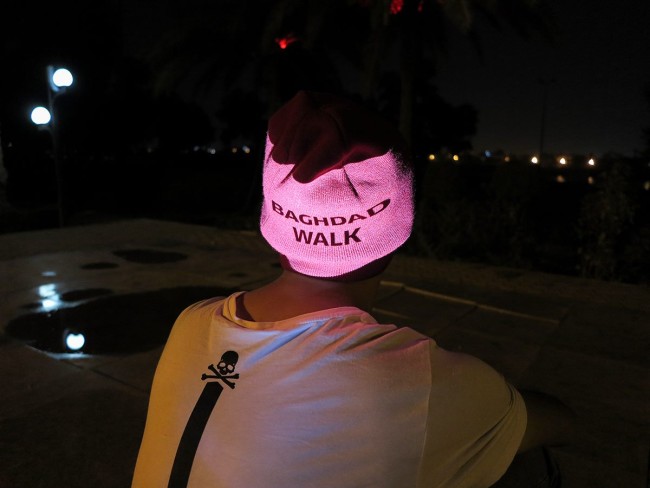
9. Zaid Saad
Zaid Saad: Sanduk (Box)On the riverbank of Tigris
Photo by Christina Werner
Photo by Christina Werner
Photo by Yasir Razaq/Mahdi Al-Shididy
Photo by Yasir Razaq/Mahdi Al-Shididy
Photo by Hella Mewis
The site-specific installation ZANDUK (the Arabic word for ‘box’) by Zaid Saad was made of eleven cardboard moving boxes. These boxes were stacked and ready to be transported to an unknown destination. They were labelled ‘From Iraq to the Sea’ and featured stencils of transportation symbols that Saad designed to signal: don’t kill them, don’t put them in jail, don’t return to sender. The installation was accompanied by a sound piece wherein the audience would listen to voices of Iraqis who shared stories about those others who had left Iraq because of the war. Saad addresses the wave of migration that has taken away many Iraqis in the last few years. Mostly the younger generations have been sent abroad, in a way similar to what governments all over the world do during wartime with national treasures and artefacts, to keep them safe outside the country. Yet people are often sent from one insecure situation to another, or even to their death. Saad lends his artistic voice to the mourning families who stay behind and lose their loved ones one way or another, ripping society off its future foundation. The installation is positioned on the riverbank of the Tigris, which leads towards the sea. In the background, on the other side of the river, the wall of the so-called International Zone, where the national decision-makers reside, is visible.
Zaid Saad: Sanduk (Box)On the riverbank of Tigris
Photo by Christina Werner
Photo by Christina Werner
Photo by Yasir Razaq/Mahdi Al-Shididy
Photo by Yasir Razaq/Mahdi Al-Shididy
Photo by Hella Mewis
The site-specific installation ZANDUK (the Arabic word for ‘box’) by Zaid Saad was made of eleven cardboard moving boxes. These boxes were stacked and ready to be transported to an unknown destination. They were labelled ‘From Iraq to the Sea’ and featured stencils of transportation symbols that Saad designed to signal: don’t kill them, don’t put them in jail, don’t return to sender. The installation was accompanied by a sound piece wherein the audience would listen to voices of Iraqis who shared stories about those others who had left Iraq because of the war. Saad addresses the wave of migration that has taken away many Iraqis in the last few years. Mostly the younger generations have been sent abroad, in a way similar to what governments all over the world do during wartime with national treasures and artefacts, to keep them safe outside the country. Yet people are often sent from one insecure situation to another, or even to their death. Saad lends his artistic voice to the mourning families who stay behind and lose their loved ones one way or another, ripping society off its future foundation. The installation is positioned on the riverbank of the Tigris, which leads towards the sea. In the background, on the other side of the river, the wall of the so-called International Zone, where the national decision-makers reside, is visible.
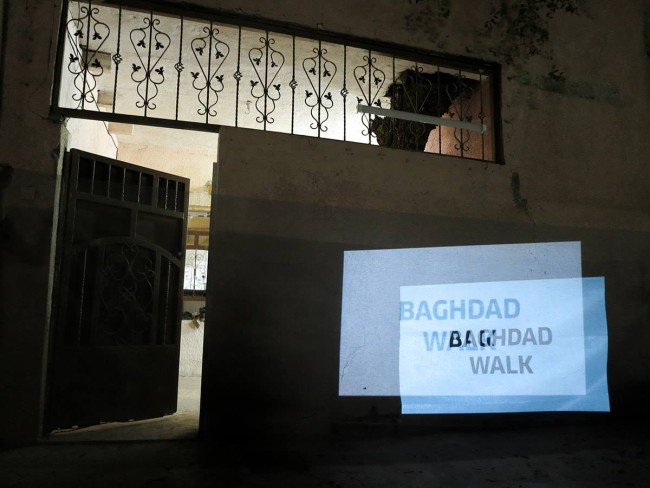
10. Atef Al Jaffal
Atef Al Jaffal: CircleStreet behind Shataa Al Jameel
Photos by Christina Werner
CIRCLE is a mural by Atef Al Jaffal, a young designer who painted a circle on the exterior wall of an ordinary one-family house and integrated eight images on plates, designed in contrasting colours, with the circle. Each design mirrors disputed issues within the Iraqi community. The images are ambivalent: a veiled woman stands for the discrepancy of tradition versus modern life, intertwined hands point to topics of gender and love, walls and roadblocks tackle questions of danger and control. Al Jaffal sees the country of Iraq as one big family. He thinks that to be able to live a normal life, the people should start to learn to respect each other and allow for different ways of being part of a community. The artist chose this ordinary family home in order to render a clear connection between the bonds of family life and how we operate in the larger community – to raise the question of how our domestic intimacies, responsibilities, and behaviour can influence our participation in society as a whole.
Atef Al Jaffal: CircleStreet behind Shataa Al Jameel
Photos by Christina Werner
CIRCLE is a mural by Atef Al Jaffal, a young designer who painted a circle on the exterior wall of an ordinary one-family house and integrated eight images on plates, designed in contrasting colours, with the circle. Each design mirrors disputed issues within the Iraqi community. The images are ambivalent: a veiled woman stands for the discrepancy of tradition versus modern life, intertwined hands point to topics of gender and love, walls and roadblocks tackle questions of danger and control. Al Jaffal sees the country of Iraq as one big family. He thinks that to be able to live a normal life, the people should start to learn to respect each other and allow for different ways of being part of a community. The artist chose this ordinary family home in order to render a clear connection between the bonds of family life and how we operate in the larger community – to raise the question of how our domestic intimacies, responsibilities, and behaviour can influence our participation in society as a whole.
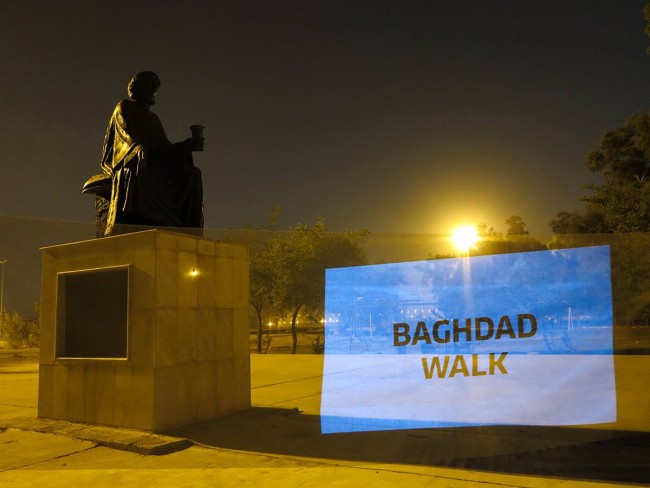
11. Husam Mohammed
Husam Mohammed: ExpressionIn front of the Abu Nawas statue
Photo by Hella Mewis
Photo by Hella Mewis
Photo by Yasir Razaq/Mahdi Al-Shididy
Photo by Hella Mewis
With his participatory work EXPRESSIONS, Husam Mohammed invited the audience to join together in a circle. He then proceeded to address each guest with a personal question, and the participants would answer each question without using words. With EXPRESSIONS, he wanted to challenge the audience and have people rely on their facial expressions, gestures, and body language as a means of communication. Mohammed is very critical of forms of expression used in social media today, such as relying on simplified icons, and he questions what the excessive use of emojis does to our everyday human interactions. The performance took place in front of the Abu Nawas statue, located in the park at the end of the boulevard Abu Nawas. The statue, designed by Ismael Fatteh and erected in 1962, honours the Iraqi poet Abu Nawas (756–814), who was a master of Arabic poetry. In poetry, the complexity and vitality of manifold ways to express human emotions stand in contrast to our reductionist forms of digital communication today. Following the performance, visitors were led back to the street; the exit was marked with a painting of faces on one side that showed lively expressions, and a sculpture resembling a judgment seat on the other side, to remind the visitors that they had the choice.
Husam Mohammed: ExpressionIn front of the Abu Nawas statue
Photo by Hella Mewis
Photo by Hella Mewis
Photo by Yasir Razaq/Mahdi Al-Shididy
Photo by Hella Mewis
With his participatory work EXPRESSIONS, Husam Mohammed invited the audience to join together in a circle. He then proceeded to address each guest with a personal question, and the participants would answer each question without using words. With EXPRESSIONS, he wanted to challenge the audience and have people rely on their facial expressions, gestures, and body language as a means of communication. Mohammed is very critical of forms of expression used in social media today, such as relying on simplified icons, and he questions what the excessive use of emojis does to our everyday human interactions. The performance took place in front of the Abu Nawas statue, located in the park at the end of the boulevard Abu Nawas. The statue, designed by Ismael Fatteh and erected in 1962, honours the Iraqi poet Abu Nawas (756–814), who was a master of Arabic poetry. In poetry, the complexity and vitality of manifold ways to express human emotions stand in contrast to our reductionist forms of digital communication today. Following the performance, visitors were led back to the street; the exit was marked with a painting of faces on one side that showed lively expressions, and a sculpture resembling a judgment seat on the other side, to remind the visitors that they had the choice.

12. Muhaned Taha
Muhaned Taha: How LongAt Kahramana Square
Photo by Yasir Razaq/Mahdi Al-Shididy
Photo by Christina Werner
Photo by Hella Mewis
Photo by Christina Werner
Photo by Christina Werner
Muhaned Taha’s installation consisted of a two-metre-high funnel filled with sand and gravel and three paintings arranged as a triangle. The paintings were crowned with the shape of a brain hovering at the rim of the funnel, tied to a bundle of white balloons. In HOW LONG, Tana talks about the connection between dream and reality. The three paintings resemble different dreams, with scenes oscillating between sweet dreams and nightmares. Taha positioned his installation to be the third object in a second, larger triangle connecting his work to two other significant objects in the nearby cityscape. The installation thereby created a dialogue with the popular Kahramana fountain by Mohammed Ghani Hikmat in Kahramana Square, which shows a figure from the story of Ali Baba and the 40 robbers, and a surveillance tower disguised as a statue shaped like a palm tree. The work created a web of associations of how society and our individual mind sets (as depicted by the literal brain) are influenced and shaped by narrations and memory, and how control evolves.
Muhaned Taha: How LongAt Kahramana Square
Photo by Yasir Razaq/Mahdi Al-Shididy
Photo by Christina Werner
Photo by Hella Mewis
Photo by Christina Werner
Photo by Christina Werner
Muhaned Taha’s installation consisted of a two-metre-high funnel filled with sand and gravel and three paintings arranged as a triangle. The paintings were crowned with the shape of a brain hovering at the rim of the funnel, tied to a bundle of white balloons. In HOW LONG, Tana talks about the connection between dream and reality. The three paintings resemble different dreams, with scenes oscillating between sweet dreams and nightmares. Taha positioned his installation to be the third object in a second, larger triangle connecting his work to two other significant objects in the nearby cityscape. The installation thereby created a dialogue with the popular Kahramana fountain by Mohammed Ghani Hikmat in Kahramana Square, which shows a figure from the story of Ali Baba and the 40 robbers, and a surveillance tower disguised as a statue shaped like a palm tree. The work created a web of associations of how society and our individual mind sets (as depicted by the literal brain) are influenced and shaped by narrations and memory, and how control evolves.
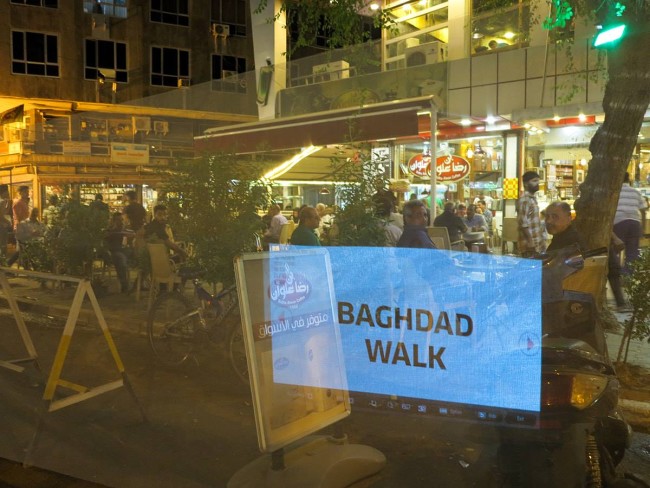
13. Ammar Hussein
Ammar Hussein: Chess (live)In front of Ridha Alwan Coffee
Photo by Christina Werner
Photo by Christina Werner
Photo by Hella Mewis
Photo by Christina Werner
Photo by Christina Werner
Ammar Hussein: Chess (live)In front of Ridha Alwan Coffee
Photo by Christina Werner
Photo by Christina Werner
Photo by Hella Mewis
Photo by Christina Werner
Photo by Christina Werner
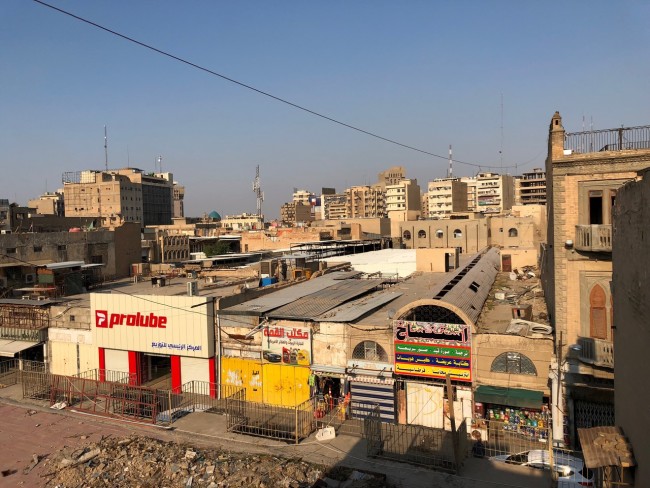
While Walking – Streetscapes
Courtyard at the Iraqi Independent Film Centre
At the Iraqi Independent Film Centre
Tigris river side
Tigris river side
Tigris river side
At Al Rasheed Street
At Al Rasheed Street
At Al Rasheed Street
At Al Rasheed Street
Abboud Building by Rifat Chadirji and Abdullah Ihsan Kamil
The Marjan Mosque
At Al Rasheed Street
At Al Rasheed Street
At Al Rasheed Street
At Al Rasheed Street
At Tahrir Square
Along Alumma Park
Along Alumma Park
At Tayeran Square
Karada Dajel
Karada Dajel
Karada Dajel
Street behind Shataa Al Jameel
At Abu Nawas Theater
At Abu Nawas Theater
Abu Nawas
Infront of the Palestine Hotel
Infront of the Palestine Hotel
Infront of the Palestine Hotel
The 17 Ramadan Mosque
At Tigris river side
Photo series by Christina Werner
Courtyard at the Iraqi Independent Film Centre
At the Iraqi Independent Film Centre
Tigris river side
Tigris river side
Tigris river side
At Al Rasheed Street
At Al Rasheed Street
At Al Rasheed Street
At Al Rasheed Street
Abboud Building by Rifat Chadirji and Abdullah Ihsan Kamil
The Marjan Mosque
At Al Rasheed Street
At Al Rasheed Street
At Al Rasheed Street
At Al Rasheed Street
At Tahrir Square
Along Alumma Park
Along Alumma Park
At Tayeran Square
Karada Dajel
Karada Dajel
Karada Dajel
Street behind Shataa Al Jameel
At Abu Nawas Theater
At Abu Nawas Theater
Abu Nawas
Infront of the Palestine Hotel
Infront of the Palestine Hotel
Infront of the Palestine Hotel
The 17 Ramadan Mosque
At Tigris river side
Photo series by Christina Werner
